The word elegance in the contemporary English enjoys two meanings. When we say “you look so elegant today” we mean it as a compliment. We are acknowledging and admiring someone’s personal taste, which is part of their emotional intelligence.
But the word elegance used to be a term. And among image consultants, it still is. The term “Elegance” refers to a very particular style. One may be impeccably dressed, but feature none of the Elegant style characteristics. For example, for her official White House portrait, Michelle Obama picked a black jersey dress with a deeply cut scye (a technical term for an arm hole). While we can always say, “Wow, she looks so elegant!” we mean it in a colloquial sense, trying to say that she has good taste and she knows what looks good on her. However, in terms of aesthetic, she is dressed in a Sporty style. The jersey fabric of her black dress and the deeply cut scye are key elements of the Sporty style. Elegant style is based on different textiles and tailoring.
I have an overview article on three classic styles: Elegant, Sporty, and Traditional. This system designed by the California Image Consultant Alyce Parsons enables image consultants to approach personal style without judgment and make educated guesses in the highly creative and intuitive process of dressing someone. Currently that article is only in the Russian part of my website, but the English version is coming shortly. Subscribe to website updates at the bottom of the page to get a notification when it is posted.
In this text I will concentrate on the key characteristics of Elegant style. I chose to use a picture of a glass pebble polished by the waves as the essence of Elegant style and a symbol of its key characteristics.
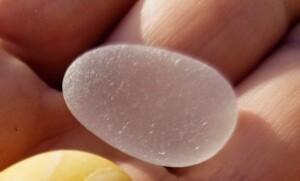
A glass pebble polished by the waves can serve a symbol of Elegant style
Elegant is: molded, smooth, elongated
Now, moving on to clothes, I will use this Max Mara Fall 2015 set as an example of Elegant style. The shoes and the purse are borrowed from the Traditional style, but this is as close as I could get to Elegance in its pure form. Elegant style has practically disappeared from runways and retail. On one hand this reflects modern times, on the other the lack of Elegant choices is the reason millions of women cannot find clothes that suit them. However, this Max Mara set will help us understand Elegant style and recreate it on our own terms.
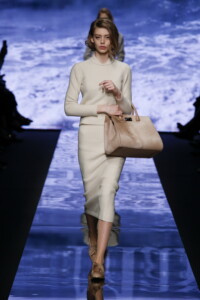
Max Mara Fall 2015 as an example of Elegant style
What are the ingredients that make this combination Elegant?
- Very subtle color. Note, it is neither black nor white, but a subdued hue of greyed beige.
- No contrast from light to dark.
- Total look: one color per entire look.
- An elongated silhouette.
- Softly contoured waist, similar to classic sculpture.
- High neckline hiding collar bones.
- Soft and smooth surface of the fabric, without elaborate texture.
- The body is softly contoured, not hidden under the clothes, though very little skin is shown.
- No sharp, angular lines
- “Invisible” shoe wear. Shoes that do not create any visual impact, but blend in with the look, creating a floating effect.
- No decorative detailing. No pocket flaps, lapels, or visible fastening anywhere on the clothes.
For men I am using a picture from the Armani campaign. The slightly more elaborate texture of the jacket and the flap pocket are borrowed from the Traditional style, but overall, this look meets the main characteristics of Elegance and we can use it as an example. The jacket, shirt, and tie are all in the same hue with no contrast from light to dark and the jacket is tailored to slightly emphasize the waist, once again reminiscent of Greco-Roman sculpture. You can run this look by all the bullet points above and see that it meets all of them, regardless of gender.
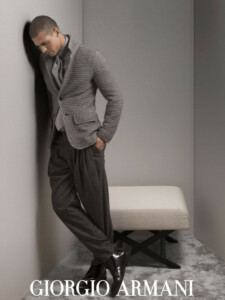
An example of Elegant style for men
Summing everything up, Elegant style emerges as a monochromatic look without strong visual accents. You won’t find bold accessories, statement shoes, vibrant colors, elaborate prints or patterns, or emphasized geometry in Elegance. It is seemingly uneventful, yet it quietly pulls us into its orbit. Being simultaneously uneventful and inviting is the essence of Elegance.
Complex, lush fabrics are partly responsible for this mysterious effect. Cashmere, virgin wool, silk and wool mixes, and crepe fabrics are essential for creating the signature Elegant look: softly contoured, non-angular, and molded. Subtle textures like pique, bird eye, and twill can be found as they provide the fabric surface with depth rather than visually exciting effects. One of the reasons Elegance has stepped aside in modern retail is the rise of fast fashion, which relies on cheaper and more affordable materials.
Taking care of clothes is another important factor. Many people think that elegant fabrics mean constant trips to the dry cleaner, but garments like cashmere sweaters and silk shirts can be washed by hand. It requires time and attentive care, but people who naturally gravitate toward soft, molded styles will often find solace in the process of caring for their clothes. Putting in time and effort resonates with their personal traits and often channels through their facial expressions, body language, and demeanor.
Recall that molded, smooth, and elongated are the key characteristics of the Elegant style. I add yet another visual to the polished pebble from the opening part of my text: a Weimaraner. This dog breed’s eye color repeats his coat color creating a monochromatic look that meets the molded, elongated lines of his body and creates the signature Elegant look.
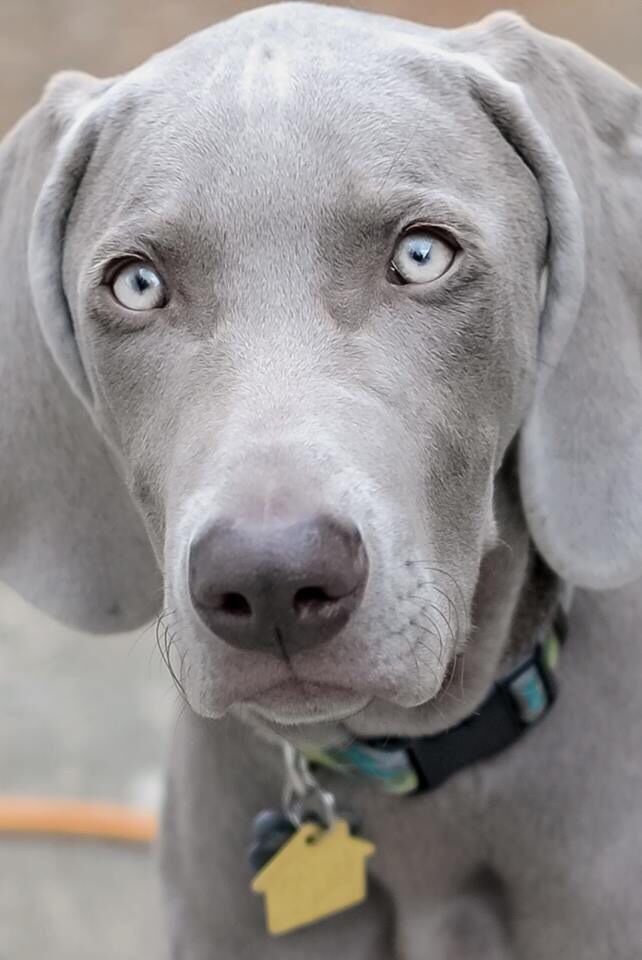
Weimaraner – a dog breed with monochromatic coloring, typical to Elegant style
Once again, the Elegant style evokes:
- moulded, smooth, elongated
- reserved, calm, pensive
Elegant style can be used to create softer looks for anyone. But for many people, Elegance serves as their core personal style. It is perceived as predominantly Euro-centric, but I have had clients and friends of different races who benefited from making Elegance their core personal style.
Usually, Elegant style resonates with certain facial features, body types, and personal characteristics. Women who find Elegant style most befitting will often be pear shaped or have elongated torsos. Both women and men tend to have softer facial features with hollow or softly contoured cheek bones, narrowing chin lines, and larger, aquiline noses. Their facial features result from their bone structure. A term used in forensics and anthropology, bone rugosity, refers to the knots on our bone surface where the soft tissue connects. There is a scale of bone rugosity and people who belong to type 1-2 will have more molded, softer facial features and are more likely to find Elegant style as their most comforting everyday style.
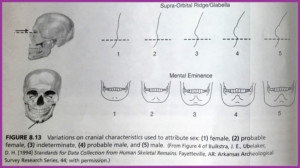
Bone Rugosity scale from “Introduction to Forensic Anthropology” by Steven Byers
This portrait of Marella Agnelli, shot by Richard Avedon in 1953, can serve as a symbol of Elegance. Her hollow cheek bones and narrowing chin with little indentation from the neck provide a visual explanation of what kind of physique feels best in Elegant style.
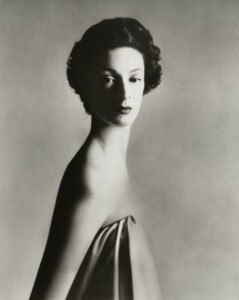
Mariella Anelli by Richard Avedon (1953)
In different systems, the following types will most likely have Elegance as their core style:
Seasonal Color Analysis: Summers and Winters. I have an overview article on Seasonal System here
Kibbe Types: Classic, Classic Dramatic, Soft Classic, Soft Drama, Romantic, Theatrical Romantic
12 Archetypes: The Ruler, The Wiseman, the Magician, the Passionate
Greek Archetypes by Jean Shinoda Bolen: Appolo, Zeus, Hades, Hera, Hestia, Athena
I like to dig into the origins of things, so I looked through various sources that explain the term Elegance. I then edited out all explicitly positive meanings such as stylish, tasteful, and neat that turned the term into a highly desirable label. By turning Elegance into praise, we have created a void, a blind spot of the particular aesthetic that so many people need defined in order to dress themselves and present themselves to the world. Here is what I ended up with.
Merriam-Webster dates the first use of the term Elegance to 1510 in a sense of urbanity. Wikipedia talks about Elegance in the context of sciences: chemistry, engineering, pharmaceutical, and also philosophy. These depictions show Elegance as a non-evident simplicity typical to technology and civilization. Therefore, Elegant merely means urban vs. rustic. Or, it did to the people living in the 1500s when the term emerged.
The shift from the rural lifestyle into the city brought more time spent indoors with closer contact between people and less physical activity. Now the main principles of Elegant style start making sense. In this new reality, new models of behavior emerged and the new traits became valuable. Inhibition, an ability to suppress impulses, becomes a very valuable personal characteristics. It feels like inhibition is at the core of Elegant style. The high, restricting necklines, or supporting necklines (it all depends on how you look at it), softer colors, and smoother surfaces helped outline and broadcast the characteristics required for survival in this indoor existence.
The emergence of science and the new layers of governmental structure and social systems are reflected through sophisticated fabrics and intricate tailoring. Hidden fastening and a lack of angularity convey hidden communications: all the hoses, beams, and girders are hidden from the eye, making technological solutions such as sewers – and electricity in the future – invisible and seemingly magical. The lack of sunlight translates into cooler, mauve- and blue-based shades.
To give you an example, look at these two pictures: A 1500s chapel on the left and Apple gadgets on the right. Look for similarities.
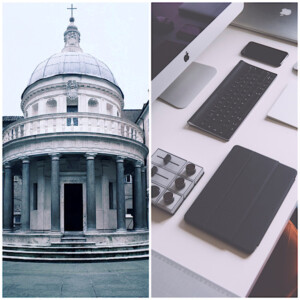
San Pietro in Montorio Chapel from the 1500 bears similarities with Apple gadgets
Both the Renaissance architecture and the XXI Century Apple gadgets have elongated, molded lines without sharp angular shapes. They feature smooth, polished surfaces and a lack of elaborate decoration. This aesthetic brings us back to classic Greco-Roman sculpture. If you add a little draping to it, you will get the formula for the Elegant style.
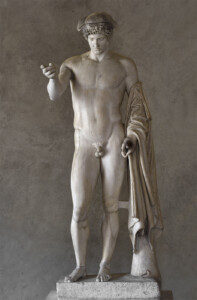
Hermes Loghios a copy after the 440 BC statue by Phidias
In her article “The Myth of Whiteness,” Margaret Talbot explains that statues in ancient Greece and Rome were often painted. The title image gives a perfect illustration of two styles: Elegant and Traditional (Urban and Rustic.) Elegant style is less eventful, with softer contouring, no sharp lines, and no bright colors. Rustic style has sharpened edges, brighter colors, and perky lines. An article on Traditional style, rooted in the Rustic, is coming soon.
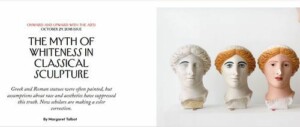
.
In the conversation about style, I always want to step aside from conditions of culture and look at nature. I wondered where in nature I could find Elegant style. What inspired the first man who created a piece– a column, pottery, a cloak– that ended up acquiring the definition of Elegant? What in nature meets the main criteria of Elegant style: molded, smooth, elongated?
Here is what I have found: the smooth bark of the eucalyptus tree once it sheds its crust, pebbles polished by waves, a waterfall, and the soft contours of sand waves in the desert. All these natural phenomena have a sense of reserve about them, the understatement and polished surfaces that we see in classic sculpture, presented to us in the Renaissance.
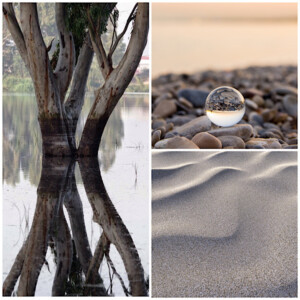
Elongated lines and and smooth surfaces are at the base of the Elegant style
Whether in nature or of human creation, the Elegant phenomenon is about engaging in a visual narrative without strong visual accents. The image is seemingly invisible, yet we keep returning to it and it pulls us into its world of understatement and reserve. This is where I can’t help thinking about the inner traits affecting our style.
Elegance is for Introverts
Elegant style is pensive and noticeably aloof. This is an image perfectly caught by Greco-Roman sculpture with relaxed poses and the gaze somewhat diffused, not focused or commanding. This gaze is very typical for people with hollow or softer cheek bones and narrower faces. People who will find Elegant style soothing will very often be reserved by nature and introverted. Their body language and facial expressions are often softer and resemble an adagio ballet style. Elegance enhances their looks, but most importantly it gives them a source of energy. Introverts are people who spend energy during social interactions and need complete solitude to replenish. Extroverts are people who spend energy in solitude and need social interaction to replenish. Highly extroverted people will find the Elegant style suffocating. They usually mix Elegance with Traditional and Dramatic styles. I will talk about these combinations later. However, introverts find pure Elegant style to be the most convenient form of channeling themselves into the world, building personal boundaries, and establishing themselves.
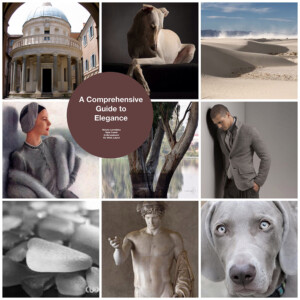
.
I hope all this helped you step outside of the laudatory implication of the word “elegant” and see it as a mere set of features that help people with certain traits build their personal style. In the world of image consulting, Elegant simply means molded, smooth, elongated and it fits certain faces, body types, and temperaments. Now, let’s move to the actual clothes. Below I have elaborated on six components that in my experience help create Elegant style in everyday wear.
1.Soft fabric with depth
2. Muted colors
3. Molded shape
4. Draping with tapering
5. Hidden fastening
6. Supporting necklines
1. Soft Fabric with Depth –
Elegance is based on three Fs: Fabric. Fabric. Fabric. The molded, flowing silhouette, the signature trait of Elegant style, owes everything to sophisticated fabric. Wool and silk blends, linen with wool, and linen with silk blends are the fundamentals of Elegant style. Crepe, cashmere, and virgin wool create similarly soft, draping lines. Cottons are only used with textures like twill and pique because they create a softer surface with some depth. Nice cotton dress shirts can be found in the men’s department and women can wear them for their casual looks with cropped pants or shorts.
Double face and crepe fabrics are perfect for creating flowing lines but they too are rare birds in modern retail. DIY Elegant style with simple fabrics like simple cottons or simple jersey will result in boring, frumpy looks. Fabric sophistication is absolutely vital for this style, therefore planning wisely, shopping consciously, finding a tailor, and a good fabric store are the avenues needed in order to get the desired results. This does sound difficult, but it also reflects the inner linings of the people who find Elegance comforting and energizing. Many introverted people enjoy the lengthy and sophisticated process of creating the soft shield between themselves and the outer world that Elegant style provides.
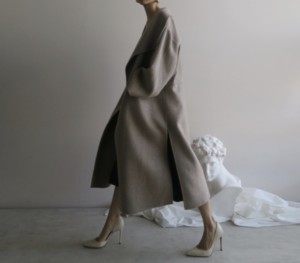
Modus
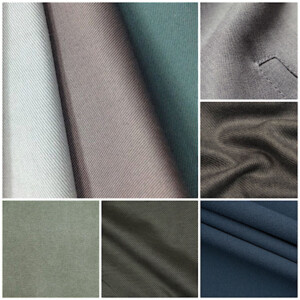
Examples of soft, mixed blends and cotton twills that create the soft lines of the Elegant style
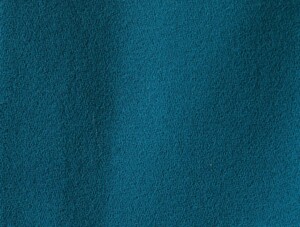
Crepe fabric instantly creates Elegant style. Click to enlarge the image and see the texture
Pure Elegant style is monochromatic and does not like to separate into dark and light. Elegance is a total look in one color or in very similar hues. What you will often see is an understated variation of soft textures, all kept in one hue. This highly nuanced grey set on the 1945 Vogue cover is a perfect example. It treats us with the understated play of textures: the soft wool of the dress, leather on the gloves, and the fur all in one hue of grey. Someone took the pain of covering buttons and the belt in the same fabric to softly emphasize the subdued sophistication of the ensemble. The turban introduces yet another texture, but it is also kept in the same hue of grey. Aslight variation of color is added through the band of the turban and the pearl strand.
The following images from the Haider Ackermann, Ermenegildo Zegna, Donna Karan, and Armani runways and St. John feature the same idea of an understated use of color in highly sophisticated, soft fabrics.
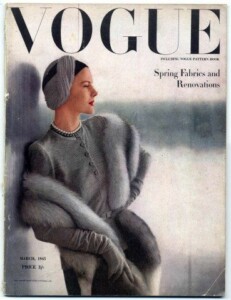
Vogue Cover 1945
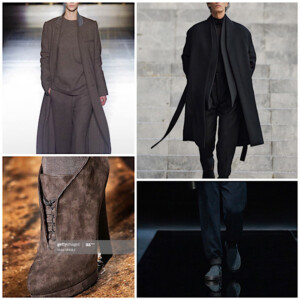
Haider Ackermann 2014. Ermenegildo Zegna 2021. Donna Karan 2014. Armani 2021.
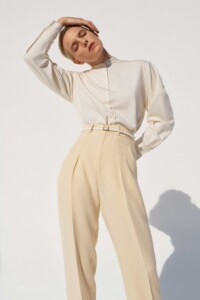
St. John Summer 2020
There is nothing angular about Elegance. It rests on the molded oval shape and rounded rectangular corners (think Apple gadgets and a pebble polished by the waves). If you see strong lines it means that Drama was added to Elegance and this is a great match that supports stronger facial features. I will write a separate text about it. Pure Elegant style is very soft and has a very pronounced inward motion. This inward vector supports introversion.
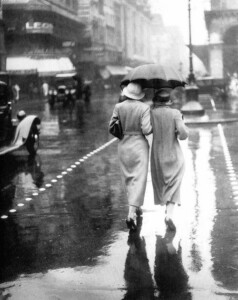
Paris, 1934. Author Unknown
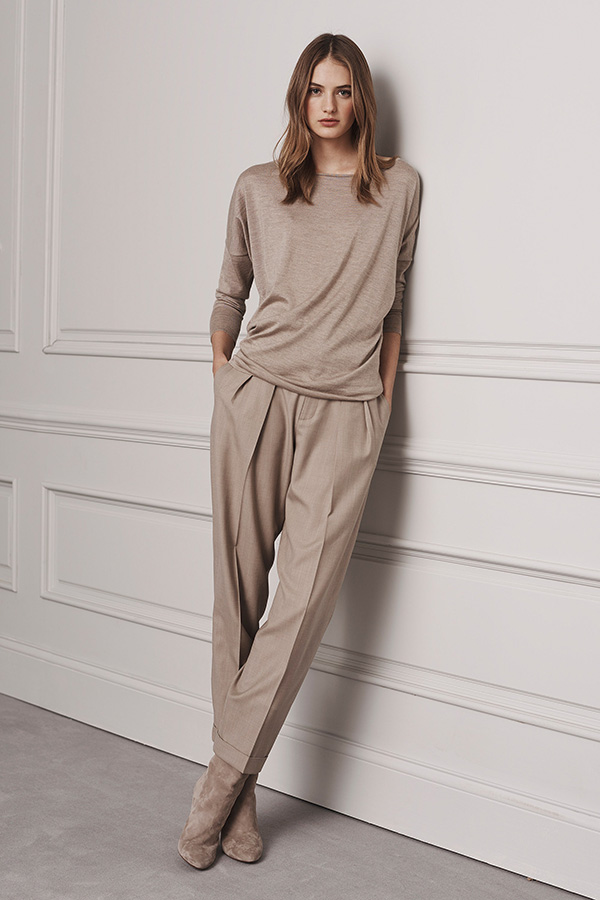
Ralph Lauren, Pre-Fall 2016
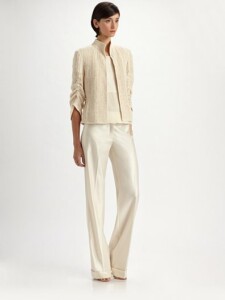
Akris
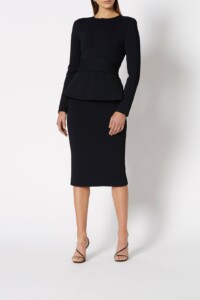
Navy blue suite by Scanlan Theodore
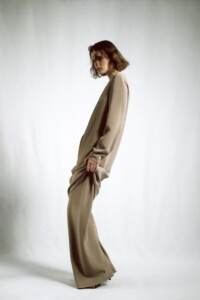
The Row Pre-Fall 2019
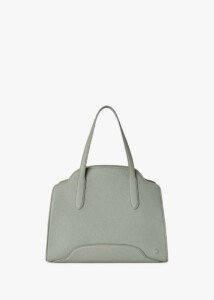
Sesia by Loro Piana features the same principle: elongated, moulded lines
Hair styles demonstrate the idea of the moulded shape. They are usually soft updos with an intricate knot on the back or a slightly elongated bob with the inward motion and no sharp edges. These hairstyles are natural for softer hair and complement moulded facial features.
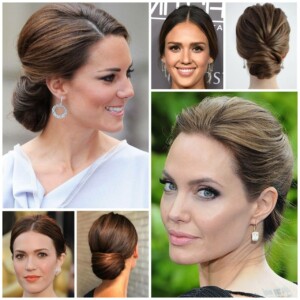
A soft updo with an intricate knot
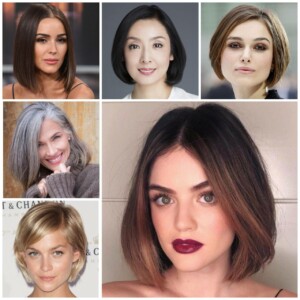
Elongated bob with inward motion and no sharp edges
Tapering provides much needed inward motion, which supports the pensive, reserved mood of Elegant style. A simple sweater with long tapered wrists meets Elegant style requirements. A pencil skirt and cropped pants tapered at the hem will tell the Elegant story. An elongated, softly contoured waistline speaks Elegance. A casual belt or cinching at the waist are attributes of other styles, Traditional, Sexy, or Dramatic, and I will cover these variations in the future articles. Elegant style creates an uninterrupted, slightly elongated waistline reminiscent of Greco-Roman sculpture.
There is one silhouette that bypasses the waist all together: a sack or cocoon dress, attributed to Balenciaga. The tapering at the hem creates the necessary inward motion that is a signature trait of Elegant style that gravitates towards introversion.
In order to have its captivating effect tapering needs draping. A slight excess of fabric is typical for Elegant style. Again, think of the draping on Greco-Roman sculptures. It can come in the shape of dolman sleeves, elaborately tapered at the cuff, full pants sweeping the floor, or a cocoon coat or dress tapered at the hem. Alber Elbaz at Lanvin was a master of the Greco-Roman drapery in casual, modern clothes. He picked up this tradition from Madeleine Vionnet.
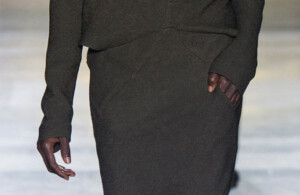
Tapered sleeves often covering the hand reminiscent of gloves. Haider Ackermann 2014
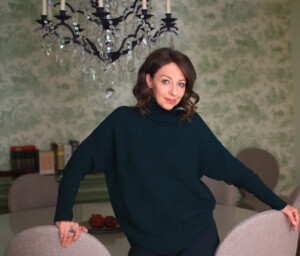
Tapered elongated cuffs on the sweater with draped sleeves. Photo by the Author
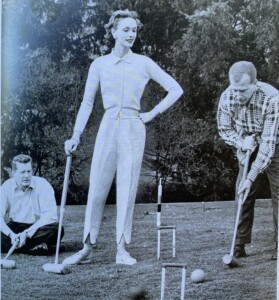
Tapered cropped trousers, relaxed fit with natural waist. Photo: Vogue USA, 1950s

Cocoon coat: the tapering at the hem provides the necessary inward vector, typical for Elegant style
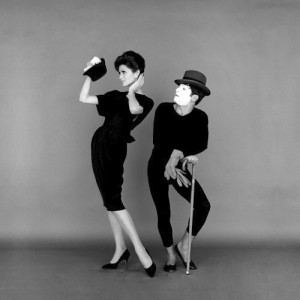
Tapered at the bottom below the knee pencil skirt. A staple of Elegant style. Photo: Jerry Schatzbert, 1960s
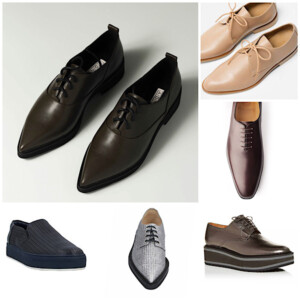
An elongated, slightly pointed toe creates good proportions in Elegant style without heels. Platforms are used for straight, wide pants and thin sole goes with the skirt
All the buttons, fastenings, and hooks are hidden. Compare this with minimalistic Apple gadgets. If buttons are present, they are covered in the same fabric as the entire garment. Buckles and belts are treated similarly. This helps translate the reserved nature of the wearer and her penchant for inhibition.
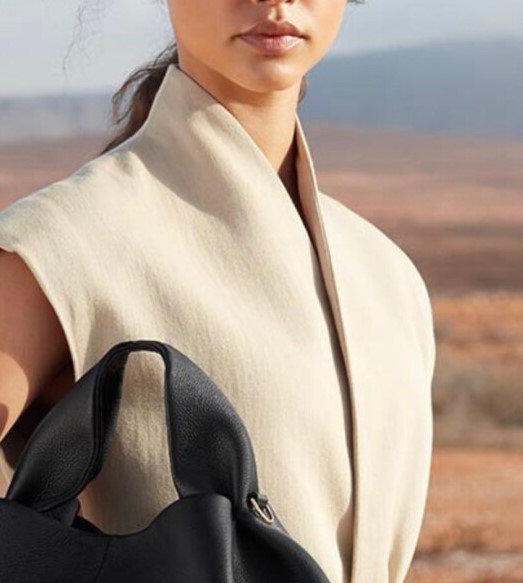
Polene 2020
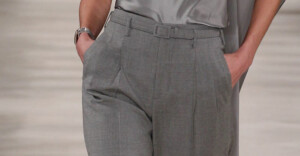
Ralph Lauren 2014
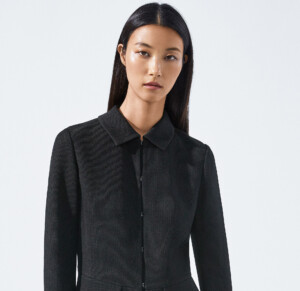
St.John Pre-Fall 2021
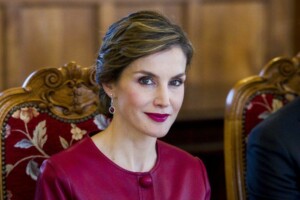
Queen of Spain Letizia gives an example of Elegant dressing by choosing her makeup and earring in one color with the suite. The button repeating the color of the garment is the key indicator of the Elegant style
A high, structured neckline is an important ambassador of Elegant style. Most of the time the neckline covers the collar bones and emphasizes the base of the neck. A more opened version, such as portrait necklines, can be seen on evening garments. Everyday pieces in the Elegant style are easily recognized by their concealing necklines such as bateau, funnel, and high crews that cover the collar bones.
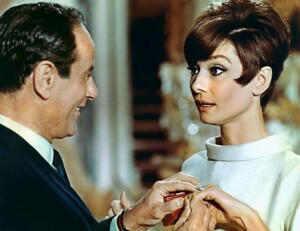
Funnel necks were a signature of Audrey Hepburn “How to Steal a Million” (1966)
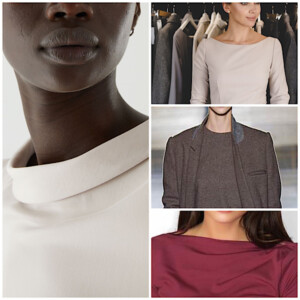
Versions of necklines, typical for Elegant style: bateau, funnel and high crew
As mentioned in the beginning of the article, it is a daring task to build a wardrobe that meets Elegant style requirements today. The fabrics and tailoring techniques are not present in modern retail. You may pick 2-3 parameters to help express a more introverted part of yourself or elevate your everyday style a bit. The presence of all six parameters creates the pure Elegant style.
Here are two modern examples where all six parameters are met. Both Angelina Jolie in The Tourist (2010) and Melania Trump for the inauguration ceremony (2017) showcase Elegant style. Their outfits meet the requirements. An elongated, molded shape without angular lines, typical of Greco-Roman sculpture. Soft draping over the shoulders and a tapered skirt. We can see the contours of the body though not much skin is revealed, and the necklines are very concealing. There are no buttons or accent accessories and the shoes are “invisible.” They are using one color for the entire set, though both colors are a bit more vibrant than pensive and aloof Elegant style wearers usually find comforting. The choice of color represents the public taste for brighter and more attention-grabbing colors. These are more typical to Traditional and Sporty styles.
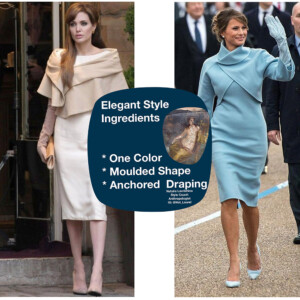
.
In the common notion, Elegant style is reserved for something important, such as formal events and festivities. However, a quick glance over designer collections reveal that Elegance has all but moved into casual wear and acquired a new name: “Elevated.” The word started popping up in the early 2010s but, after the staged text exchange between Anna Wintour and Rihanna published by Vogue in June of 2014
it has cemented itself in the urban dictionary. In the exchange, Rihanna sends Wintour a casual white tee look with golden chains and sport shorts and receives a brief response: Elevate. After that, the word began popping up more frequently in the fashion press, indicating a more polished and refined casual look and it seems to be reflected in the collections as well.
I will talk about the modern route the Elegant style took in my next article. Please sign up for site updates at the bottom of the page to get notifications when articles are posted. If you feel that Elegant style calls to you as your basic style and you want it in its pure form, here is the checklist of its staple items.
List of Staple Items for Elegant Style for Women
- Midi-skirt made of crepe or wool and silk blend fabtic, with a natural waist or slightly high-waisted, tapered at the bottom.
- Soft, body-con silk and cashmere sleeveless sweater with bateau, funnel or high crew-neckline covering the collar bones and straight arm hole, covering the shoulder bone. Find out more about the scye here
- Soft, body-con virgin wool sweater with bateau, funnel or high crew neckline, covering the collar bones, sleeves with elongated, tapered cuffs, covering the base of the thumb.
- Straight pants made of crepe or wool blend fabric, opening at the foot 9-11 inches to cover two thirds of the shoe. Natural waist or slightly high-waisted.
- Tailored jacket without lapels or with very narrow lapels, 1 – 1/2 inches wide and softened edges. Crepe or wool blend fabric.
- Tailored calf-length coat with slight drape. No lapels or very narrow 1 – 1 1/2 inches wide lapels and welt pockets.
- Elegance does not automatically mean the discomfort of the heels. Ballet flats or oxford laced shoes with slightly elongated toe that match the skin-tone or hose color. Straight pants call for platform oxrords and debry, skirts look better with thinner sole.
- Pashmina in the color similar to the entire outfit without fringe in one color or ombre.
List of Staple Items for Elegant Style for Men
- Straight pants made of fine wool without pattern, with natural waist or slightly high waisted.
- Silk jersey sweater, or silk and cotton blend sweater without pattern or with birds eye pattern with sleek sleeves and high crew neckline at the base of the neck with non-contrast neckline trimming.
- Summer long sleeve shirts of a silk and linen blend. The sleeves are worn rolled up, which creates the framing effect.
- Dress shirts made of cotton pique without patterns and prints.
- Cashmere sweater without patterns or prints with high crew neckline at the base of the neck.
- Tailored jacket made of fine wool or wool, silk and cashmere blend with narrow lapels 1 – 2 inches and welt pockets.
- Tailored coat, above the knee, made of fine wool and cashmere blend with narrow lapels, 1 – 2 inches wide with welt pockets.
- Snood made of smooth fabric matching the colors of jersey. Worn on the neck as a scarf.
- Shoes with slightly elongated toes in one color matching the colors of the trousers with no contrasting sole or laces.
I hope this information was useful for you. I am a Silicon Valley based image consultant working with clients online since 2008. Please contact me at lavrishina@gmail.com if you want a private consultation.
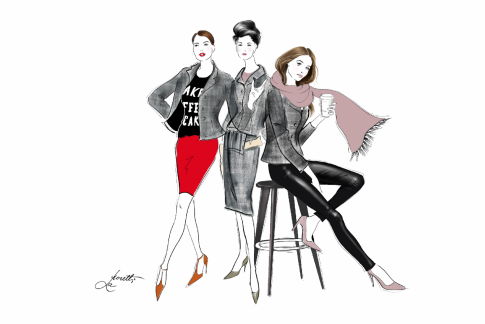

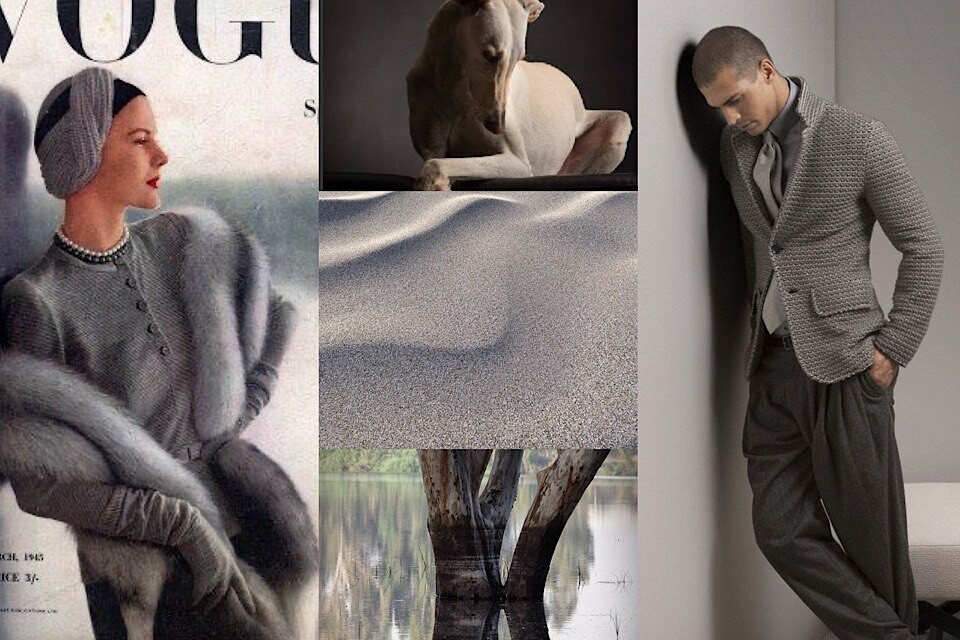







































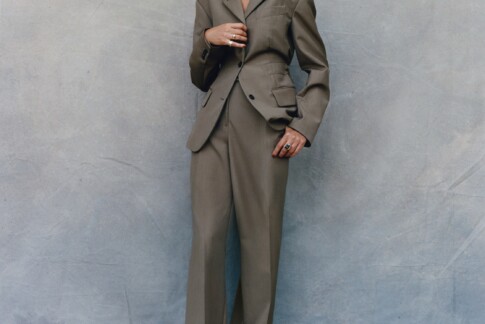
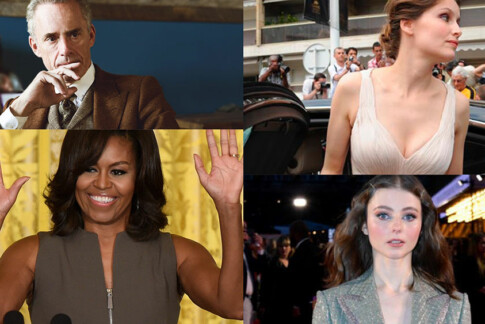
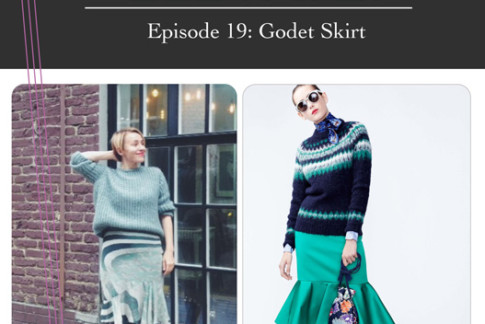
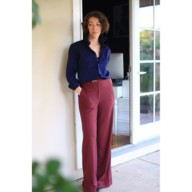
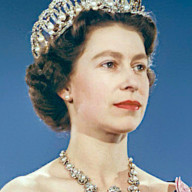
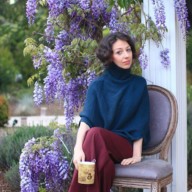
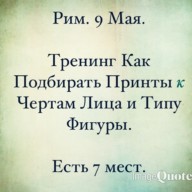
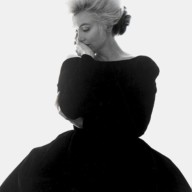
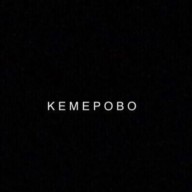
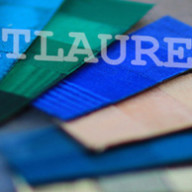

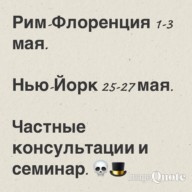
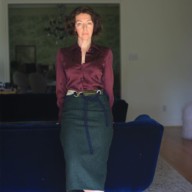
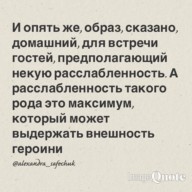
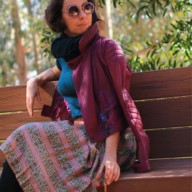
would very much like to get information when your overveiw article on “three classic styles: Elegant, Sporty, and Traditional. This system designed by the California Image Consultant Alyce Parsons enables image consultants to approach personal style without judgment and make educated guesses in the highly creative and intuitive process of dressing someone” is available in english, best regards